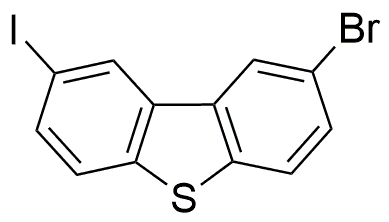2-Bromo-8-iododibenzothiophene is widely utilized in research focused on:
- Organic Electronics: This compound is used in the development of organic semiconductors, which are essential for creating flexible electronic devices such as OLEDs (Organic Light Emitting Diodes) and organic solar cells.
- Pharmaceutical Research: Its unique structure makes it a valuable building block in the synthesis of novel pharmaceuticals, particularly in the development of compounds targeting specific biological pathways.
- Material Science: The compound is explored for its potential in creating advanced materials with tailored electronic properties, useful in sensors and other electronic applications.
- Environmental Studies: Researchers utilize it to study the behavior of organic pollutants in the environment, aiding in the development of remediation strategies.
- Photovoltaic Applications: It is investigated for its role in enhancing the efficiency of solar cells, contributing to the advancement of renewable energy technologies.
Informations générales
Propriétés
Sécurité et réglementation
Applications
2-Bromo-8-iododibenzothiophene is widely utilized in research focused on:
- Organic Electronics: This compound is used in the development of organic semiconductors, which are essential for creating flexible electronic devices such as OLEDs (Organic Light Emitting Diodes) and organic solar cells.
- Pharmaceutical Research: Its unique structure makes it a valuable building block in the synthesis of novel pharmaceuticals, particularly in the development of compounds targeting specific biological pathways.
- Material Science: The compound is explored for its potential in creating advanced materials with tailored electronic properties, useful in sensors and other electronic applications.
- Environmental Studies: Researchers utilize it to study the behavior of organic pollutants in the environment, aiding in the development of remediation strategies.
- Photovoltaic Applications: It is investigated for its role in enhancing the efficiency of solar cells, contributing to the advancement of renewable energy technologies.
Documents
Fiches de données de sécurité (FDS)
La FDS fournit des informations de sécurité complètes sur la manipulation, le stockage et l’élimination du produit.
Spécifications du produit (PS)
Le PS fournit une description complète des propriétés du produit, notamment sa composition chimique, son état physique, sa pureté et les exigences de stockage. Il détaille également les plages de qualité acceptables et les applications prévues du produit.
Certificats d'analyse (COA)
Recherchez des certificats d'analyse (COA) en saisissant le numéro de lot du produit. Les numéros de lot et de lot se trouvent sur l'étiquette d'un produit, après les mots « Lot » ou « Lot de fabrication ».
Numéro de catalogue
Numéro de lot/série
Certificats d'origine (COO)
Ce certificat d'exploitation confirme le pays dans lequel le produit a été fabriqué, et détaille également les matériaux et composants utilisés et s'il est issu de sources naturelles, synthétiques ou autres sources spécifiques. Ce certificat peut être requis pour les douanes, le commerce et la conformité réglementaire.
Numéro de catalogue
Numéro de lot/série
Fiches de données de sécurité (FDS)
La FDS fournit des informations de sécurité complètes sur la manipulation, le stockage et l’élimination du produit.
DownloadSpécifications du produit (PS)
Le PS fournit une description complète des propriétés du produit, notamment sa composition chimique, son état physique, sa pureté et les exigences de stockage. Il détaille également les plages de qualité acceptables et les applications prévues du produit.
DownloadCertificats d'analyse (COA)
Recherchez des certificats d'analyse (COA) en saisissant le numéro de lot du produit. Les numéros de lot et de lot se trouvent sur l'étiquette d'un produit, après les mots « Lot » ou « Lot de fabrication ».
Numéro de catalogue
Numéro de lot/série
Certificats d'origine (COO)
Ce certificat d'exploitation confirme le pays dans lequel le produit a été fabriqué, et détaille également les matériaux et composants utilisés et s'il est issu de sources naturelles, synthétiques ou autres sources spécifiques. Ce certificat peut être requis pour les douanes, le commerce et la conformité réglementaire.


